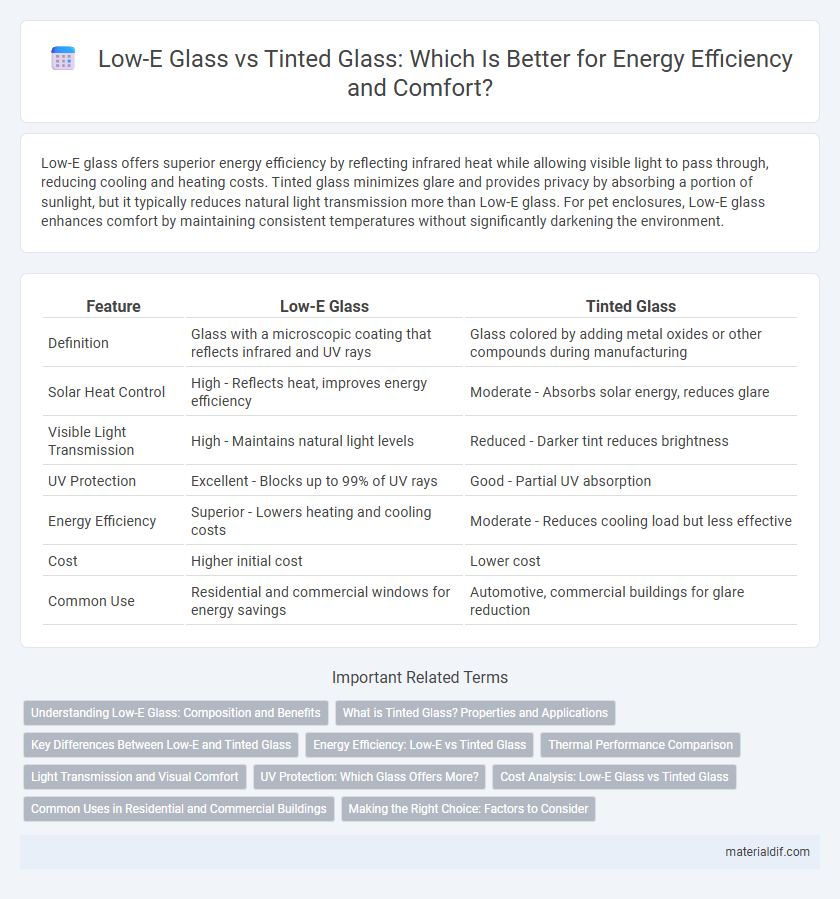Low-E glass offers superior energy efficiency by reflecting infrared heat while allowing visible light to pass through, reducing cooling and heating costs. Tinted glass minimizes glare and provides privacy by absorbing a portion of sunlight, but it typically reduces natural light transmission more than Low-E glass. For pet enclosures, Low-E glass enhances comfort by maintaining consistent temperatures without significantly darkening the environment.
Table of Comparison
| Feature | Low-E Glass | Tinted Glass |
|---|---|---|
| Definition | Glass with a microscopic coating that reflects infrared and UV rays | Glass colored by adding metal oxides or other compounds during manufacturing |
| Solar Heat Control | High - Reflects heat, improves energy efficiency | Moderate - Absorbs solar energy, reduces glare |
| Visible Light Transmission | High - Maintains natural light levels | Reduced - Darker tint reduces brightness |
| UV Protection | Excellent - Blocks up to 99% of UV rays | Good - Partial UV absorption |
| Energy Efficiency | Superior - Lowers heating and cooling costs | Moderate - Reduces cooling load but less effective |
| Cost | Higher initial cost | Lower cost |
| Common Use | Residential and commercial windows for energy savings | Automotive, commercial buildings for glare reduction |
Understanding Low-E Glass: Composition and Benefits
Low-E glass features a microscopically thin coating of metallic oxides applied to the surface, which reflects infrared energy while allowing visible light to pass through, enhancing energy efficiency in buildings. This smart coating reduces heat transfer, keeping interiors warmer in winter and cooler in summer, resulting in significant energy savings and improved comfort. Unlike tinted glass, which merely darkens the glass to reduce glare, Low-E glass maintains natural daylighting while offering superior thermal insulation and UV protection.
What is Tinted Glass? Properties and Applications
Tinted glass is a type of glass treated with additives or coatings to reduce solar heat gain and glare by absorbing a portion of the sunlight. Its properties include enhanced privacy, ultraviolet (UV) ray protection, and improved energy efficiency, often found in automotive windows, building facades, and skylights. Common applications of tinted glass encompass commercial buildings for reducing cooling costs, residential windows for comfort and privacy, and automotive industries to protect interiors from sun damage while maintaining clear visibility.
Key Differences Between Low-E and Tinted Glass
Low-E glass features a microscopically thin coating that reflects infrared and ultraviolet light, significantly improving energy efficiency by reducing heat transfer while maintaining visible light transmission. Tinted glass absorbs a portion of solar radiation, decreasing glare and heat gain but often reducing natural light and altering window appearance. Key differences include Low-E's superior insulating properties and UV protection versus tinted glass's ability to provide shading and privacy.
Energy Efficiency: Low-E vs Tinted Glass
Low-E glass improves energy efficiency by reflecting infrared heat while allowing visible light to pass through, reducing heating and cooling costs. Tinted glass primarily reduces solar heat gain by absorbing sunlight, which can decrease cooling loads but often at the expense of natural daylight. Low-E coatings provide better overall thermal insulation and daylighting performance compared to tinted glass, making it more effective for energy-efficient building designs.
Thermal Performance Comparison
Low-E glass significantly outperforms tinted glass in thermal performance by utilizing a microscopically thin metallic coating that reflects infrared energy, reducing heat transfer while allowing visible light to pass through. Tinted glass primarily absorbs solar radiation, which can increase the glass temperature and contribute to heat buildup indoors. Consequently, Low-E glass offers superior energy efficiency and indoor temperature regulation compared to tinted glass.
Light Transmission and Visual Comfort
Low-E glass features a microscopic metallic coating that selectively reduces infrared and ultraviolet light while maintaining high visible light transmission, enhancing natural daylight without glare. Tinted glass lowers overall light transmission by absorbing a portion of the solar spectrum, which can reduce brightness but sometimes distorts color perception and visibility. For superior visual comfort, Low-E glass balances solar heat control and clarity, making it ideal for spaces requiring natural light with minimal glare and UV exposure.
UV Protection: Which Glass Offers More?
Low-E glass provides superior UV protection by incorporating microscopically thin metallic layers that reflect up to 99% of harmful ultraviolet rays, significantly reducing fading of interior furnishings. Tinted glass primarily reduces visible light and heat transmission but offers less effective UV blocking compared to Low-E glass. For optimal UV protection in residential and commercial applications, Low-E glass is the preferred choice.
Cost Analysis: Low-E Glass vs Tinted Glass
Low-E glass typically costs 10% to 20% more than tinted glass due to its advanced coating technology that enhances energy efficiency by reflecting infrared and ultraviolet rays. Although the upfront investment is higher, Low-E glass provides better thermal insulation, resulting in significant long-term energy savings and reduced HVAC expenses. Tinted glass, while cheaper initially, offers less energy efficiency and may lead to increased cooling costs over time.
Common Uses in Residential and Commercial Buildings
Low-E glass is commonly used in residential and commercial buildings for energy-efficient windows, reducing heat transfer and improving insulation while allowing natural light. Tinted glass is often installed in commercial facades and residential sunrooms to reduce glare and solar heat gain, enhancing comfort and privacy. Both types of glass contribute to building performance, with Low-E glass prioritized for thermal control and tinted glass for shading and aesthetic appeal.
Making the Right Choice: Factors to Consider
Low-E glass offers superior energy efficiency by reflecting infrared heat while allowing natural light, reducing heating and cooling costs, whereas tinted glass primarily reduces glare and blocks visible sunlight but may darken interiors excessively. Consider factors such as climate, desired light transmission, thermal insulation needs, and aesthetic preferences when choosing between Low-E and tinted glass. Evaluating the balance between energy savings, UV protection, and interior ambiance is crucial to making the right glazing decision.
Low-E glass vs Tinted glass Infographic

 materialdif.com
materialdif.com